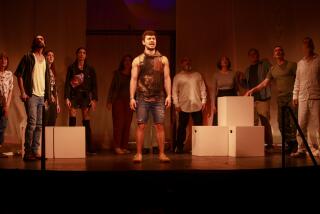A Shark in Friendly Waters : Dancer and Coach From Original ‘West Side Story’ Helps Stage UCI Version
- Share via
IRVINE — Soon after “West Side Story” opened on Broadway in 1957, director-choreographer Jerome Robbins asked his friend Donald McKayle to come on as dance captain to help rehearse the musical and to step in for sick or injured dancers.
McKayle, today a UC Irvine dance professor who has been nominated for five Tonys for his own Broadway choreography, accepted Robbins’ offer and appeared often as a Shark, gang rival of the Jets.
Now, more than three decades later, McKayle has helped stage a university production of the show, which opens tonight at the Irvine Barclay Theatre. McKayle’s participation held a promising notion for UCI students: He could pass on what he learned working with Robbins and composer Leonard Bernstein during the infancy of one of America’s greatest musicals. He could impart the dramatic intent and physical dynamic behind every movement and gesture.
McKayle, who conceived and realized the new production with director Eli Simon, had no interest in a clone job, however. Both men envisioned something more current.
Like an AK-47 and a pocketknife, today’s gangs have little in common with gangs of the 1950s, around which the modern-day Romeo and Juliet story revolves.
“Back then, you could just quit if you wanted out of a gang,” said McKayle, who has choreographed and staged the UC Irvine School of Fine Arts production. “Today, you could be killed for that.”
“So much has changed with gangs, and our consciousness (about them) has changed,” Simon added during a recent rehearsal break. An exact reproduction of the original musical “would have been a period piece,” he said.
McKayle and Simon haven’t altered the intent or story of star-crossed lovers Tony and Maria, nor tampered with Bernstein’s score or Stephen Sondheim’s lyrics.
But they’ve put a contemporary spin on just about everything else.
Nike running shoes, baggy sweat pants, micro-miniskirts and black bustiers a la Madonna have replaced pristine white T-shirts, cuffed blue jeans, bobby sox and knee-length shifts. Dancers carry link chain and clubs, not just switchblades.
In place of a brick wall background are colorful floor-to-ceiling panels created by aerosol artist Raul Gamboa, who has fashioned a wild urban cityscape with huge, Day-Glo block letters, graffiti scribblings and fanciful figures that looks so up-to-the-second you can almost smell the spray paint.
As for the choreography, McKayle went to what he calls the “neighborhood” to capture the feel of what he sees on the street or in dance clubs.
“Some of the moves would fit right into the vernacular dance of today,” he said. “But you won’t see any MTV routines. It’s not as slicked out as that. I tried to keep it very much so you believe these are people, rather than performers.”
Describing the dance movement as “rough-edged” and “explosive,” he said audiences also won’t see the balletic lyricism of the original by Robbins, who has spent much of his 50-year career choreographing for the New York City Ballet. Despite his Tony nominations, McKayle probably is best known for his modern-dance works, some of which are considered American classics--including “Games” (1951) and “Rainbow ‘Round My Shoulder” (1959).
In his adaptation, he said that rather than completing every movement, “you start something and cut it off before it finishes. You make a statement of ‘I am. I exist’ ” by freezing midstream to draw attention to the dancer.
In addition, McKayle said the ‘90s version is sexier than its predecessor, heated up with sudden hip thrusts and sensual pelvic gyrations.
“That’s part of the vernacular,” he said.
He also has included women in some fight sequences to reflect the fact that gang violence is no longer exclusively the domain of men.
“I’ve utilized women throughout the whole prologue as combatants. They aren’t at home primping,” he said. “That’s not what’s happening today at all.”
McKayle, 61, has worked with professional dancers on Broadway, racking up credits that include “Sophisticated Ladies” and “Raisin.” He faced a challenge in putting together a student production that requires acting, singing and dancing from nearly every cast member.
“Quite a few of the actors have never studied dance. In the first few rehearsals, I was really doing basic training: ‘Right foot, left foot, come on now. . . .’
But the Laguna Beach resident, who had his own New York troupe from 1951 to 1969 and has taught at such leading institutions as New York’s Juilliard School and the California Institute of the Arts in Valencia, relished the process.
“I’ve always loved developing talent, and what I’ve seen in terms of the growth of these young performers is just amazing,” he said.
Choosing to put his own choreographic stamp on such a well-known work--seen by millions on Broadway and film--could have posed a challenge that some wouldn’t accept.
“If there’s something that speaks to you as an artist, you have to see it through your own head,” he said.
At least one cast member is fully behind the venture.
“This was a risk, and I guess it remains to be seen if it’s a success,” said Larry Sousa, who plays Riff, the lead male Jet. “But I’d opt for this risk any day.”
UC Irvine’s School of Fine Arts production of “West Side Story” runs at 8 p.m. tonightthrough Nov. 30, except Thanksgiving night, at the Irvine Barclay Theatre, 4242 Campus Drive, Irvine. Matinee at 2 p.m. Nov. 30. Tickets: $12 to $15. Information: (714) 856-6616 or (714) 854-4646.
More to Read
The biggest entertainment stories
Get our big stories about Hollywood, film, television, music, arts, culture and more right in your inbox as soon as they publish.
You may occasionally receive promotional content from the Los Angeles Times.










